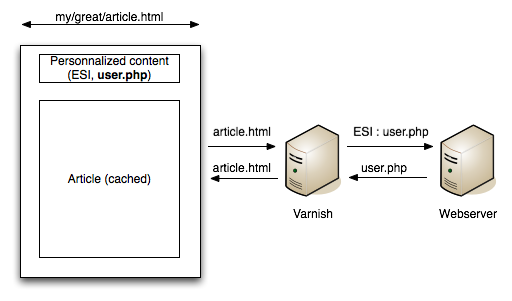React ESI is a super powerful cache library for vanilla React and Next.js applications, that can make highly dynamic applications as fast as static sites.
It provides a straightforward way to boost your application's performance by storing fragments of server-side rendered pages in edge cache servers.
It means that after the first rendering, fragments of your pages will be served in a few milliseconds by servers close to your end users!
It's a very efficient way to improve the performance and the SEO of your websites and to dramatically reduce both your hosting costs and the energy consumption of these applications. Help the planet, use React ESI!
Because it is built on top of the Edge Side Includes (ESI) W3C specification, React ESI natively supports most of the well-known cloud cache providers including Cloudflare Workers, Akamai and Fastly. Of course, React ESI also supports the open source Varnish cache server that you can use in your own infrastructure for free (configuration example).
Also, React ESI allows the specification of different Time To Live (TTL) per React component and generates the corresponding HTML asynchronously using a secure (signed) URL. The cache server fetches and stores in the cache all the needed fragments (the HTML corresponding to every React component), builds the final page and sends it to the browser. React ESI also allows components to (re-)render client-side without any specific configuration.
Schema from The Varnish Book
Discover React ESI in depth with this presentation
Using NPM:
$ npm install react-esi
Or using Yarn:
$ yarn add react-esi
Or using PNPM:
$ pnpm add react-esi
React ESI provides a convenient Higher Order Component that will:
- replace the wrapped component with an ESI tag server-side (don't worry React ESI also provides the tooling to generate the corresponding fragment);
- render the wrapped component client-side, and feed it with the server-side computed props (if any).
React ESI automatically calls a static async method named getInitialProps() to populate the initial props of the component. Server-side, this method can access to the HTTP request and response, for instance, to set the Cache-Control header, or some cache tags.
These props returned by getInitialProps() will also be injected in the server-side generated HTML (in a <script> tag).
Client-side the component will reuse the props coming from the server (the method will not be called a second time).
If the method hasn't been called server-side, then it will be called client-side the first time the component is mounted.
// pages/App.jsx
import withESI from "react-esi/lib/withESI";
import MyFragment from "../components/MyFragment";
const MyFragmentESI = withESI(MyFragment, "MyFragment");
// The second parameter is an unique ID identifying this fragment.
// If you use different instances of the same component, use a different ID per instance.
export const App = () => (
<div>
<h1>React ESI demo app</h1>
<MyFragmentESI greeting="Hello!" />
</div>
);// components/MyFragment.jsx
import React from "react";
export default class MyFragment extends React.Component {
render() {
return (
<section>
<h1>A fragment that can have its own TTL</h1>
<div>{this.props.greeting /* access to the props as usual */}</div>
<div>{this.props.dataFromAnAPI}</div>
</section>
);
}
static async getInitialProps({ props, res }) {
return new Promise((resolve) => {
if (res) {
// Set a TTL for this fragment
res.set("Cache-Control", "s-maxage=60, max-age=30");
}
// Simulate a delay (call to a remote service such as a web API)
setTimeout(
() =>
resolve({
...props, // Props coming from index.js, passed through the internal URL
dataFromAnAPI: "Hello there",
}),
2000
);
});
}
}The initial props must be serializable using JSON.stringify(). Beware Map, Set, and Symbol!
Note: for convenience, getInitialProps() has the same signature as the Next.js one.
However, it's a totally independent and standalone implementation (you don't need Next.js to use it).
To serve the fragments, React ESI provides a ready-to-use controller compatible with Express, check out the full example.
Alternatively, here is a full example using a Next.js server:
- Support Varnish, Cloudflare Workers, Akamai, Fastly, and any other cache systems having ESI support
- Written in TypeScript
- Next.js-friendly API
React ESI can be configured using environment variables:
REACT_ESI_SECRET: a secret key used to sign the fragment URL (default to a random string, it's highly recommended to set it to prevent problems when the server restart, or when using multiple servers)REACT_ESI_PATH: the internal path used to generate the fragment, should not be exposed publicly (default:/_fragment)
To pass attributes to the <esi:include> element generated by React ESI, pass a prop having the following structure to the HOC:
{
esi: {
attrs: {
alt: "Alternative text",
onerror: "continue"
}
}
}By default, most cache proxies, including Varnish, never serve a response from the cache if the request contains a cookie.
If you test using localhost or a similar local domain, clear all pre-existing cookies for this origin.
If the cookies are expected (e.g.: Google Analytics or ad cookies), then you must configure properly your cache proxy to ignore them. Here are some examples for Varnish.
To allow the client-side app to reuse the props fetched or computed server-side, React ESI injects <script> tags containing them in the ESI fragments.
After the assembling of the page by the cache server, these script tags end up mixed with the legit HTML.
These tags are automatically removed from the DOM before the rendering phase.
React ESI plays very well with advanced cache strategies including:
- Cache invalidation (purge) with cache tags (Varnish / Cloudflare)
- Warming the cache when data changes in the persistence layer (Varnish)
Give them a try!
We love Vue and Nuxt as much as React and Next, so we're currently porting React ESI for this platform. Contact us if you want to help!
Created by Kévin Dunglas. Sponsored by Les-Tilleuls.coop.




